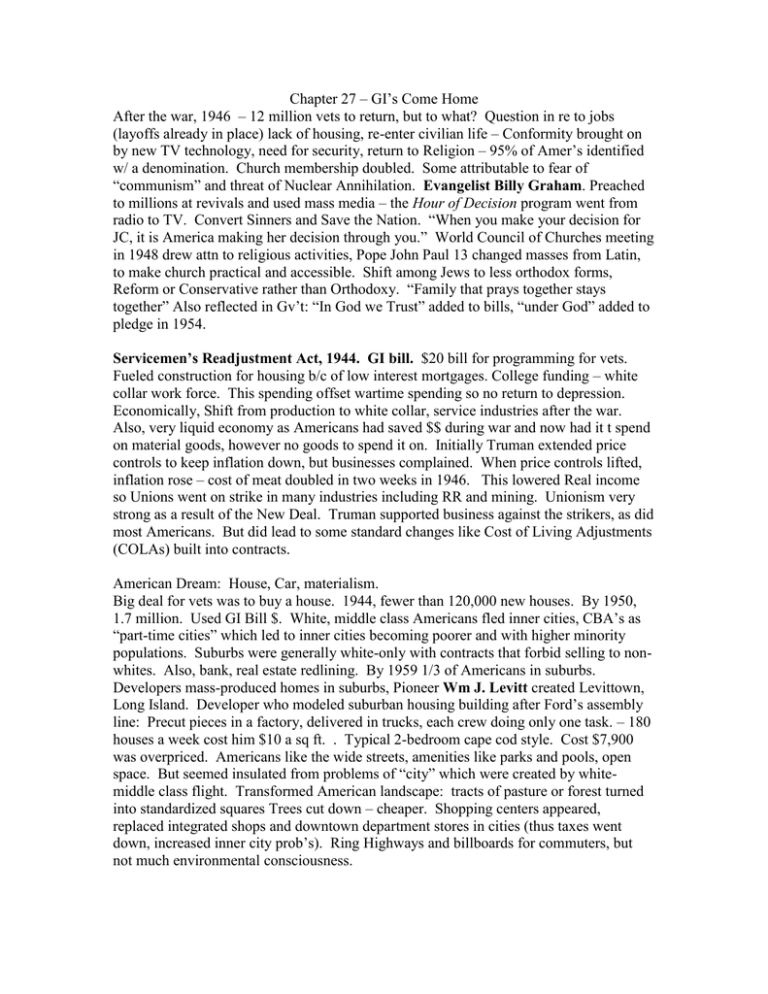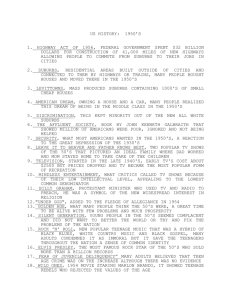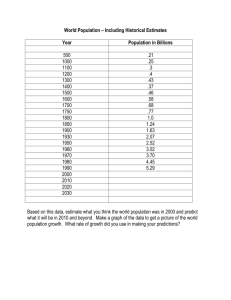Chapter 27 – GI’s Come Home.doc
advertisement

Chapter 27 – GI’s Come Home After the war, 1946 – 12 million vets to return, but to what? Question in re to jobs (layoffs already in place) lack of housing, re-enter civilian life – Conformity brought on by new TV technology, need for security, return to Religion – 95% of Amer’s identified w/ a denomination. Church membership doubled. Some attributable to fear of “communism” and threat of Nuclear Annihilation. Evangelist Billy Graham. Preached to millions at revivals and used mass media – the Hour of Decision program went from radio to TV. Convert Sinners and Save the Nation. “When you make your decision for JC, it is America making her decision through you.” World Council of Churches meeting in 1948 drew attn to religious activities, Pope John Paul 13 changed masses from Latin, to make church practical and accessible. Shift among Jews to less orthodox forms, Reform or Conservative rather than Orthodoxy. “Family that prays together stays together” Also reflected in Gv’t: “In God we Trust” added to bills, “under God” added to pledge in 1954. Servicemen’s Readjustment Act, 1944. GI bill. $20 bill for programming for vets. Fueled construction for housing b/c of low interest mortgages. College funding – white collar work force. This spending offset wartime spending so no return to depression. Economically, Shift from production to white collar, service industries after the war. Also, very liquid economy as Americans had saved $$ during war and now had it t spend on material goods, however no goods to spend it on. Initially Truman extended price controls to keep inflation down, but businesses complained. When price controls lifted, inflation rose – cost of meat doubled in two weeks in 1946. This lowered Real income so Unions went on strike in many industries including RR and mining. Unionism very strong as a result of the New Deal. Truman supported business against the strikers, as did most Americans. But did lead to some standard changes like Cost of Living Adjustments (COLAs) built into contracts. American Dream: House, Car, materialism. Big deal for vets was to buy a house. 1944, fewer than 120,000 new houses. By 1950, 1.7 million. Used GI Bill $. White, middle class Americans fled inner cities, CBA’s as “part-time cities” which led to inner cities becoming poorer and with higher minority populations. Suburbs were generally white-only with contracts that forbid selling to nonwhites. Also, bank, real estate redlining. By 1959 1/3 of Americans in suburbs. Developers mass-produced homes in suburbs, Pioneer Wm J. Levitt created Levittown, Long Island. Developer who modeled suburban housing building after Ford’s assembly line: Precut pieces in a factory, delivered in trucks, each crew doing only one task. – 180 houses a week cost him $10 a sq ft. . Typical 2-bedroom cape cod style. Cost $7,900 was overpriced. Americans like the wide streets, amenities like parks and pools, open space. But seemed insulated from problems of “city” which were created by whitemiddle class flight. Transformed American landscape: tracts of pasture or forest turned into standardized squares Trees cut down – cheaper. Shopping centers appeared, replaced integrated shops and downtown department stores in cities (thus taxes went down, increased inner city prob’s). Ring Highways and billboards for commuters, but not much environmental consciousness. Prosperity also created a consumer culture. Americans saw it as they’re due after depression and wartime rationing. Love for gadgets and appliances – fridges, washing machine, Vacuum cleaner, electric can openers, aerosol sprays. Big one was TV – new cultural icon and influence on American Life. Howdy Doody and I love Lucy. Families watched 5 hrs a day in 1955. TV ads Bought TVs at 250,000 a year in 1949. Advertisers had come of age in the 1920s. Convinced consumers that buying stuff brought status and satisfaction. Also led to consumer credit, installment plans, and credit cards Diner’s Club in 1950. Then Amex and BankAmericard. Consumer indebtedness increased from $8.4 bill in 1946 to $45 bill in 1958 Price is Right on TV. Advertisers also tried to encourage housewives to think of themselves as professionals who needed many specialized products in order to do their jobs, while discouraging housewives from having actual careers, since that would mean they would not spend as much time and effort on housework and therefore would not buy as many household products, cutting into advertisers' profits. Growth of importance of Family in Amer life after Depression costs of war. Increase of Marriages after record lows during Depression. The ww2 war vets were the most ‘marrying generation.’ 97% of women and 94% of men, also marrying younger – ave. age in 1950 under 20 y.o. Increase in family and size, Baby Boom peaked in 1957. Number of children went from 2.6 in 1940 to 3.2 in 1950. Birthrates for 3rd children went up X2, and for 4th children X3. A baby born every 7 seconds in 1957. Amer population grew by 20 million. Strained school systems as children entered school; increased demand for child-related services and products (diapers).





